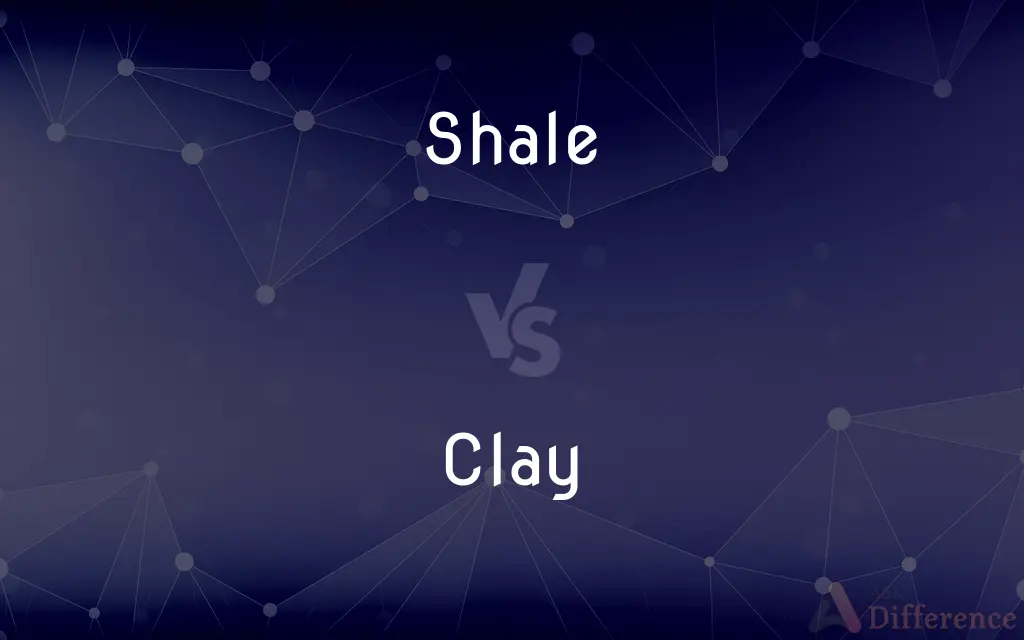Shale vs. Clay — What's the Difference?
By Urooj Arif & Fiza Rafique — Updated on February 20, 2024
Shale is a fine-grained sedimentary rock formed from compacted mud, notable for its fissility, whereas clay is a natural, earthy material composed of fine-grained minerals, primarily used in ceramics and construction.

Difference Between Shale and Clay
Table of Contents
ADVERTISEMENT
Key Differences
Shale and clay are closely related materials found in the Earth's crust, integral to various geological and industrial processes. Shale is a sedimentary rock that originates from the compaction of silt and clay minerals over long periods. Its defining characteristic is its fissility, meaning it can easily be split into thin layers. This property makes shale an important source rock for fossil fuels like oil and natural gas, as organic materials trapped within its layers can, under the right conditions, transform into hydrocarbons.
Clay, on the other hand, refers to a group of fine-grained natural earth materials that become pliable when wet. Clays are distinguished by their particle size and mineral composition, which typically includes minerals like kaolinite, illite, and smectite. Due to its plasticity when moist and hardening when fired or dried, clay is a fundamental material in the making of bricks, pottery, and ceramics.
The primary difference between shale and clay lies in their composition and use. Shale, being a rock, is a consolidated form that includes clay minerals as part of its composition but also contains other materials such as quartz and organic matter. Clay is more homogeneous and is valued for its unique properties in art and construction rather than its geological significance.
In terms of industrial application, shale is explored for its potential in oil and gas production, particularly through processes like hydraulic fracturing ("fracking"), which releases trapped hydrocarbons. Clay's industrial applications are more varied, ranging from pottery and sculpture to the manufacture of building materials and even in cosmetics and pharmaceuticals for its absorbent properties.
Despite their differences, both shale and clay play crucial roles in environmental and economic contexts. Shale formations can act as aquifers or natural filters for groundwater, while clay's absorbent qualities make it useful in environmental remediation efforts.
ADVERTISEMENT
Comparison Chart
Composition
Compact mud (silt and clay minerals) with possible organic materials
Fine-grained minerals (e.g., kaolinite, illite, smectite)
Form
Sedimentary rock
Natural, earthy material
Properties
Fissile, splits easily into thin layers
Plastic when wet, hardens when dried or fired
Uses
Source rock for oil and gas, construction material
Pottery, ceramics, bricks, construction, environmental applications
Significance
Geological (hydrocarbon source), industrial
Industrial, artistic, environmental
Compare with Definitions
Shale
Used in construction, particularly as a raw material for cement and bricks.
Shale is crushed and mixed into the cement for added strength.
Clay
A natural, fine-grained material with plastic properties when wet, used extensively in ceramics and construction.
She molded the clay into a beautiful vase on the potter's wheel.
Shale
A fine-grained sedimentary rock formed from compacted mud, characterized by its ability to split into thin layers.
The quarry extracts shale for use in building and landscaping.
Clay
Composed of various minerals, making it crucial in different types of ceramics.
Kaolinite clay is preferred for making fine porcelain.
Shale
Often serves as a source rock for oil and natural gas due to organic material content.
Geologists study shale formations to assess their potential for oil extraction.
Clay
Used in environmental cleanup due to its absorbent properties.
Clay liners are used in landfills to prevent leachate from contaminating groundwater.
Shale
Can vary in color from gray to black, green, or red, depending on mineral content.
The greenish hue of the shale is due to its iron content.
Clay
Plays a role in health and beauty products as a natural absorbent and cleanser.
The facial mask contains clay to absorb oils and toxins from the skin.
Shale
Fissility makes it useful in geological studies to understand past environmental conditions.
The layering in shale provides clues about Earth's historical climate changes.
Clay
Hardens and becomes durable when fired, making it ideal for bricks and tiles.
The clay bricks were fired at high temperatures to build the kiln.
Shale
Soft finely stratified sedimentary rock that formed from consolidated mud or clay and can be split easily into fragile plates.
Clay
Clay is a type of fine-grained natural soil material containing clay minerals. Clays develop plasticity when wet, due to a molecular film of water surrounding the clay particles, but become hard, brittle and non–plastic upon drying or firing.
Shale
A sedimentary rock formed by the deposition of successive layers of clay
Common Curiosities
What's the environmental impact of extracting shale for oil and gas?
Extraction can lead to water contamination, air pollution, and habitat disruption, raising concerns about fracking's environmental footprint.
Can shale turn into clay?
Shale does not turn into clay; rather, shale forms from compacted clay and silt over geological time.
How does the use of shale in oil production work?
Shale acts as a source rock for oil and gas, which can be extracted through drilling and hydraulic fracturing, releasing hydrocarbons trapped in the rock's pores.
Why is clay preferred in making ceramics and pottery?
Its plasticity when wet allows for shaping, and its hardening properties upon drying or firing make it durable and versatile for various applications.
Are there different types of clay for different uses?
Yes, different types of clay, such as kaolin, bentonite, and ball clay, are selected based on their mineral content and properties for specific uses in ceramics, construction, and even in health and beauty products.
Is clay found in shale?
Yes, clay minerals are a primary component of shale, along with silt and sometimes organic matter.
Can you make pottery out of shale?
Directly, no. Shale is not used for pottery, but clay extracted from or associated with shale deposits can be.
What role does shale play in water filtration?
While not directly used in filtration, shale formations can act as aquifers or barriers influencing groundwater flow and quality.
How are shale and clay similar?
Both contain fine-grained minerals and can originate from similar depositional environments, but they differ significantly in hardness, permeability, and uses.
What is the significance of shale's color variations?
The color of shale can indicate the presence of certain minerals or organic materials, which can provide clues about the conditions under which the rock was formed.
Share Your Discovery

Previous Comparison
Frenzy vs. Craze
Next Comparison
Administrator vs. AdministrativeAuthor Spotlight
Written by
Urooj ArifUrooj is a skilled content writer at Ask Difference, known for her exceptional ability to simplify complex topics into engaging and informative content. With a passion for research and a flair for clear, concise writing, she consistently delivers articles that resonate with our diverse audience.
Co-written by
Fiza RafiqueFiza Rafique is a skilled content writer at AskDifference.com, where she meticulously refines and enhances written pieces. Drawing from her vast editorial expertise, Fiza ensures clarity, accuracy, and precision in every article. Passionate about language, she continually seeks to elevate the quality of content for readers worldwide.















































